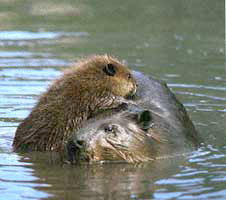A Walk in the Evening Forest
Living in nature — in harmony with it! — one comes to many surprising discoveries and encounters. As if the nature lifts, for its good friends, the veil which hides from ordinary people the life of wild forest inhabitants.
For example, once we accidentally woke up a hare sleeping on a place of power.
Once, other hare run by us when we were meditating on a place of power. It stopped and stared at us with amusement and curiosity: what do these people do here?
… I recall one remarkable evening. We set up a camp in the forest near a small river. Formerly, its channel had been about two meters wide, but after beavers had constructed a dam on it, the river turned into a pond, which became a dwelling place of various birds: ducks, gulls, sandpipers. Since then, every evening and morning the air was filled with beautiful songs of thrushes, robins, chiff-chaffs; snipes “bleat” by their tails…
That evening I decided to take a walk in the forest, upstream along the river — to seek new places of power. At some point, I heard a sound of waterfall. I went to that sound… and found myself in a beavers’ “dining room”. One more settlement of beavers! Everywhere around, there were felled aspens with fresh marks of beavers’ teeth. It was a whole beavers’ household! I could see “ventilation” holes for air passage to the beavers’ burrows (the entrance to a burrow is located underwater). There was an impressive construction — a dam built by them. The water was rolling over it, making a waterfall.
Due to such dams, rivers flood, the water level increases, and this makes a pond. This creates favorable conditions for beavers: the entrances to their burrows remain hidden under the water, and the beavers themselves have a lot of space for swimming, for finding and storing food. Usually they store aspen and willow branches on the bottom of the water reservoir.
Where the banks are low and boggy, beavers build their lodges: constructions of sticks covered with mud; inside such a lodge there is a living chamber.
A living chamber — either in a lodge or in a burrow — necessarily has several exits.
But do not think that beavers feed only on twigs and bark. In winter and in summer, they eat grassy plants; in winter — those growing on the river bottom.

… Stepping very quietly, I came to the very bank of the beavers’ pond… And, for the first time, I saw these animals so close as I had never seen before! Two beavers were swimming toward each other, only their snouts visible above the water surface. They met and touched each other by snouts — making a beavers’ kiss. Then they simultaneously slapped by the tails, expressing the joy of meeting, and dived. Their dinnertime came.
I hid on the bank and watched the life of these nice animals. Near me, one of them stood on the hind feet and bit off a big splinter from a birch — to eat it in a convenient position.
Suddenly I heard rustle in the leaves of a fallen aspen. And I saw another beaver, with a branch in its mouth, coming out from the leaves and going to the water.
For a long time, I heard the sound of their teeth working…
… In the water, beavers feel more confident than on the ground; there they are like fish: quick and agile!
In the water, beavers can move at the speed of 10 kilometers per hour. And they can stay underwater up to 15 minutes.
Beavers’ families are strong: usually partners form a life-long pair. In summer, female gives birth to several babies (from 2 to 5); they are born sighted and covered with soft hair. Two days old, they are capable of going out from the home and swimming. During the first one and a half months of life, they feed on the mother’s milk; later they can eat bark.
In wild, beavers live up to 20 years and even more.
… But it was not the last surprise for me in that evening. I heard rustle behind my back. “Beavers surround me,” thought I and turned back. And there… about 5 meters from me a foxie was running by. This animal is so beautiful! Especially — its bushy tail!
Again there was a rustle and snorting sound behind — very close to me! I peered there: “What kind of animal is there?” It was a mole coming to the surface to take a breath of fresh air — and to go down again to its underground kingdom.
… Coming back to the camp, I saw a stock-dove (wild pigeon) from a very close distance: I nearly run into a young bird sitting on a tree stump.
In that wonderful evening, it seemed to me that I am in a magical forest where wild animals were not afraid of humans and behaved naturally, paying no attention to me present among them.
To enlarge any photo on the screen — click on it with mouse.
Authors of photographs: Anna Zubkova, Olga Stepanets, Anton Teplyy, Ekateria Smirnova.
The photo of a beaver with a baby was copied from http://www.starosti-net.nm.ru/bforce.htm
